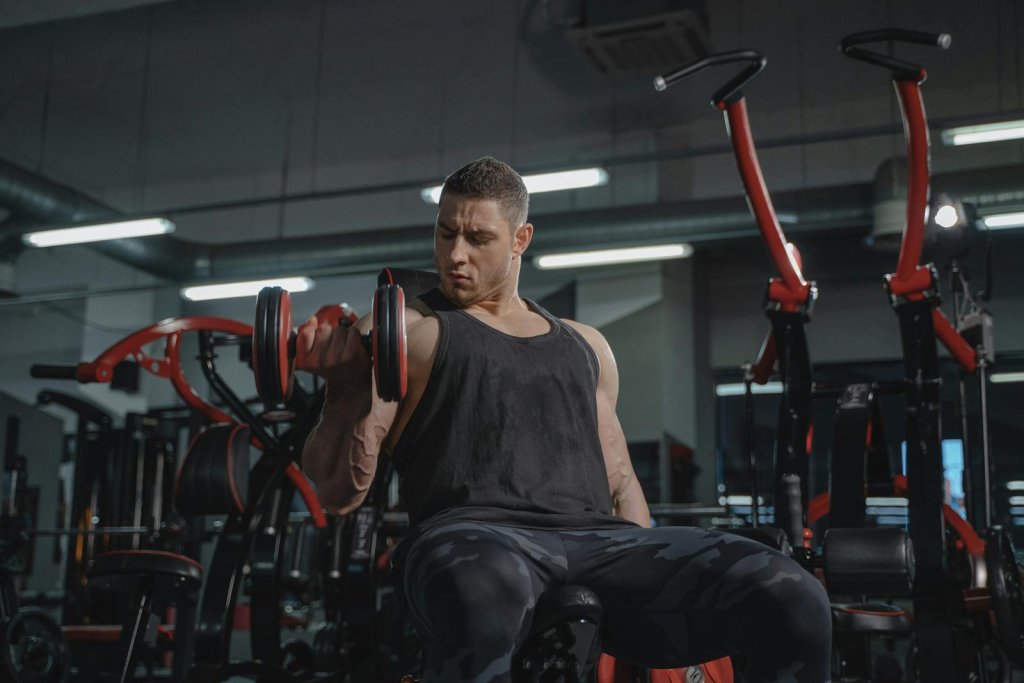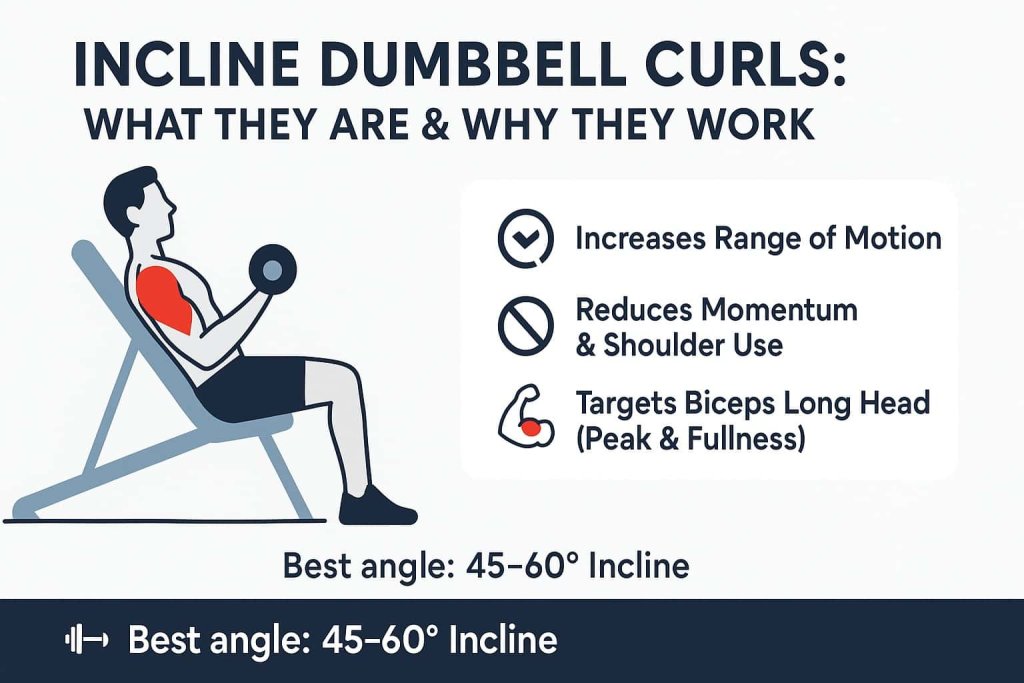Incline dumbbell curls are one of the most effective exercises for building bigger, fuller biceps—especially the long head. By performing curls on an incline bench, you place your arms in a stretched position that maximizes muscle activation and growth.

Understanding this movement is important because it provides benefits that standard curls can’t—greater range of motion, strict isolation, and a stronger mind-muscle connection. With the right setup, form, and progression, incline dumbbell curls can become the secret weapon in your arm training routine.
What Are Incline Dumbbell Curls?
Incline dumbbell curls are performed while sitting on an incline bench (usually set at 45–60 degrees). Unlike standing curls, your arms hang behind your torso, putting the biceps in a stretched position before you even lift the weight.

This setup:
- Increases the range of motion.
- Reduces momentum and shoulder involvement.
- Places more emphasis on the biceps brachii long head, the portion of the muscle that adds peak and fullness.
Benefits of Incline Dumbbell Curls

1. Greater Stretch for More Growth
Studies suggest that “stretch-mediated hypertrophy” — training muscles in lengthened positions — leads to superior muscle growth. Incline curls maximize this effect by placing the biceps in a fully stretched position before the contraction begins (Built With Science, 2024).
2. Long Head Activation
The incline angle emphasizes the long head of the biceps, the part responsible for arm “peak.” This helps create a more aesthetic, fuller look.
3. Strict Form and Isolation
The bench prevents swinging and cheating, forcing your biceps to do most of the work. This reduces the involvement of shoulders and traps that often take over in standing curls.
4. Unilateral Training Option
Incline curls can be performed one arm at a time to fix imbalances in strength or size.
5. Variation from Standard Curls
Adding incline curls into your program prevents adaptation and ensures you’re hitting the biceps from different angles.
How to Perform Incline Dumbbell Curls Correctly
Setup
- Adjust an incline bench to 45–60 degrees.
- Sit back with feet flat on the ground.
- Let your arms hang fully extended, palms facing forward.
Execution
- Curl the dumbbells upward without moving your upper arms.
- Squeeze your biceps hard at the top.
- Lower slowly under control until arms are fully extended.
Pro Tips
- Don’t let elbows drift forward.
- Use moderate weight to maintain form.
- Focus on the mind-muscle connection—feel the biceps stretch and contract.
Common Mistakes to Avoid
- Using too much weight → Leads to swinging and shoulder involvement.
- Elbow movement → Reduces isolation of the biceps.
- Shortening the range of motion → Skipping the stretch at the bottom reduces effectiveness.
- Leaning forward → Eliminates the advantage of the incline position.
Incline Dumbbell Curl Variations
1. Incline Hammer Curl
How it Differs:
Instead of a supinated grip (palms up), you hold the dumbbells with neutral palms facing each other throughout the movement.
Muscles Worked:
- Brachialis (deep arm muscle that pushes biceps up)
- Biceps brachii
- Forearms (brachioradialis)
Why It Works:
The incline position stretches the biceps, while the hammer grip adds forearm and brachialis activation. This gives the arms a thicker, fuller look.
Trainer Tip:
Don’t swing your arms—keep the elbows fixed and move only through the elbow joint for maximum tension.
2. Incline Alternating Curl
How it Differs:
You perform curls one arm at a time instead of curling both simultaneously.
Benefits:
- Greater focus and mind-muscle connection on each arm
- Allows slight torso rotation for a stronger contraction
- Helps identify and fix strength imbalances
Trainer Tip:
Keep the non-working arm fully extended at the bottom to maintain constant stretch.
3. Incline Zottman Curl
How it Differs:
Curl up like a normal incline dumbbell curl (palms up), then rotate palms down on the way down (eccentric phase).
Benefits:
- Biceps get hit on the way up
- Forearms and brachioradialis overloaded on the way down
- Excellent for balanced arm development
Trainer Tip:
Control the lowering phase—take 3–4 seconds to maximize forearm recruitment.
4. Facing-Away Cable Curl
How it Differs:
Performed on a low cable machine, standing with your back to the stack. The angle mimics an incline dumbbell curl but adds constant tension from the cable.
Benefits:
- No dead spots in the range of motion
- Smooth resistance, great for hypertrophy
- Safer for joints compared to free weights
Trainer Tip:
Step slightly forward to maintain cable tension even at the bottom of the rep.
Incline Dumbbell Curls vs Other Bicep Curls
- Incline vs Standing Curl: Standing curls engage stabilizers, but incline curls isolate biceps more.
- Incline vs Preacher Curl: Preacher curls emphasize the short head, incline curls emphasize the long head. Using both creates balanced development (Community Strength, 2023).
- Incline vs Concentration Curl: Concentration curls are stricter but don’t provide the same stretch advantage.
Programming Incline Dumbbell Curls
- Reps & Sets: 3–4 sets of 8–12 reps.
- Placement: Do them early in your workout to maximize bicep isolation when you’re fresh.
- Progression: Gradually increase weight or slow down the eccentric phase (lowering) for growth.
FAQs About Incline Dumbbell Curls
1. Do incline curls build bigger biceps than standard curls?
Yes, because they train the biceps in a stretched position, which is linked to greater muscle hypertrophy.
2. What angle is best for incline dumbbell curls?
A 45–60 degree incline is ideal for maximizing stretch without stressing the shoulders.
3. Should I use heavy or light weights?
Moderate weights are best—focus on form, tension, and full range of motion.
4. Can beginners do incline curls?
Yes. Start light, perfect form, and gradually increase resistance.
5. How often should I do them?
1–2 times per week is enough as part of a balanced arm routine.
6. Do incline curls work forearms too?
They primarily target biceps, but forearms act as stabilizers, especially in hammer curl variations.
7. Should I do incline curls before or after compound lifts?
After big lifts (like rows or pull-ups), but early in your arm-focused session.
Conclusion
Incline dumbbell curls are a proven way to build bigger, fuller biceps by emphasizing the long head and maximizing stretch. With strict form and controlled execution, they outperform many traditional curl variations. Add them to your routine, progress gradually, and you’ll see noticeable improvements in size and shape.
